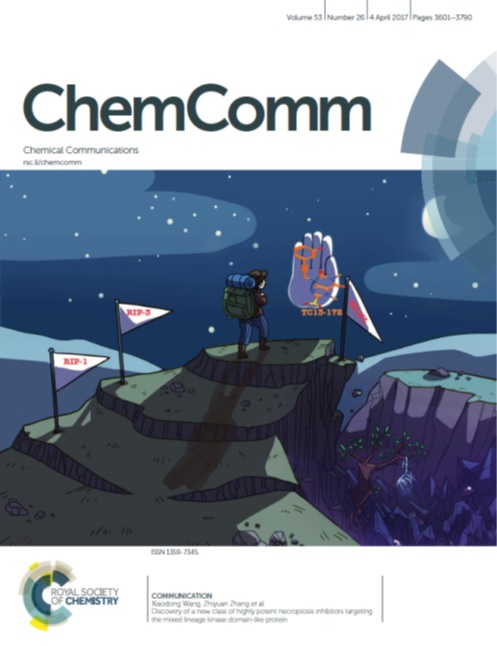Research News
Discovery of a new class of highly potent necroptosis affected targeting the mixed lineage kinase domain-like protein
April 4, 2017 – Dr. Zhi-Yuan Zhang and Dr. Xiao-Dong Wang of NIBS, Beijing published a research article entitled “Discovery of a new class of highly potent necroptosis affected targeting the mixed lineage kinase domain-like protein” in Chemical Communications (DOI: 10.1039/c7cc00667e). The accompanying artwork decorates the cover of the CC issue in which the article is published.

Explanation of the cover artwork: RIP1,RIP3 and MLKL are sequentially activated during the programmed cell necroptosis pathway, and MLKL is the executioner. A highly potent small molecule (TC013-172) inhibits the action of MLKL, and efficiently rescues dying cells.
Necroptosis is one of the important discoveries in the recent biological field. The studies of Xiaodong Wang's laboratory and other research groups have revealed that RIP1, RIP3 and MLKL are important components in necroptosis pathway. MLKL, as the executor of necroptosis, can form oligomers and translocate to cellular membranes upon necroptosis signal stimulation, where it mediates ion influx and/or causes the disruption of cell structures. Recent studies have established that MLKL is involved in multiple human inflammatory diseases, including acute pancreatitis, multiple sclerosis, inflammatory bowel disease, and allergic colitis. In this context, MLKL is viewed as a potential therapeutic target for drug discovery.
Zhiyuan Zhang’s laboratory has been focusing on drug development and new methods of target identification. Wang Xiaodong laboratory has been working on the mechanism of necroptosis. Two laboratories collaborated to perform a cell-based high-throughput screen to identify necroptosis inhibitors using a chemical library of ~200,000 compounds and identified several hit compounds that protected human colorectal adenocarcinoma (HT-29) cells from TNF-α/Smac mimetic/Z-VAD-fmk (TSZ)-induced necroptosis. Among these hits, one was identified as a RIP1 inhibitor and was further developed into the highly potent and selective anti-inflammation reagent RIPA-56 (Ren Y, J. Med. Chem, 2017). Another hit from this high-throughput screen, compound 1, has good anti-necroptosis potency (EC50 = 390 ± 8 nM). While compound 1 did not inhibit the kinase activities of RIP1 or RIP3 at concentrations up to 10 µM, it did compete with NSA to bind MLKL, suggesting that MLKL but not RIP1 or RIP3 should be a target of compound 1.
In order to obtain direct evidence that compound 1 targets MLKL, authors synthesized a series of derivatives of compound 1 based on medicinal chemistry effort with the aim of increasing its anti-necroptosis potency and obtaining a high affinity probe for target identification. Finally, authors successfully improved the potency of the initial hit, compound 1, from an EC50 value of 390 nM, all the way down to an EC50 value of 2 nM (compound 15). This important achievement demonstrates that MLKL is a druggable target and provides useful chemical tools to study the function of MLKL.
Based on the established structure-activity relationship, the authors synthesized the highly potent probe 12 and successfully identified the target using the newly developed BTC-ABPP method (Sun, H., Chem. Comm. 2016). Compounds 12 and 15 were found to covalently bind Cys-86 of MLKL and inhibit the oligomerization and translocation of MLKL to the cell membrane. The discovery of the novel and potent MLKL inhibitors reported here will almost certainly be of benefit in exploring the biological function of MLKL, including its role in necroptosis-related disease pathogenesis.
Bo Yan of NIBS and Lei Liu of CAMS & PUMC are co-first authors of this article. Zhi-yuan Zhang and Xiao-dong Wang are the corresponding authors. Other contributors include Shao-qiang Huang, Yan Ren, Zhen-lin Yao, Lin Li and She Chen from NIBS, Huayi-Wang from Shanghai Tech University. This research was supported by a grant of the Beijing Municipal Science & Technology Commission and the grant of the 973 Program. This work was carried out at the National Institute of Biological Sciences, Beijing.



